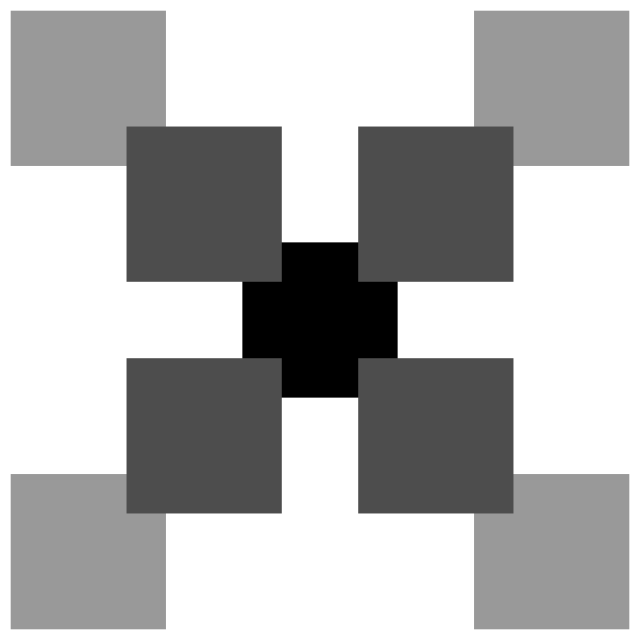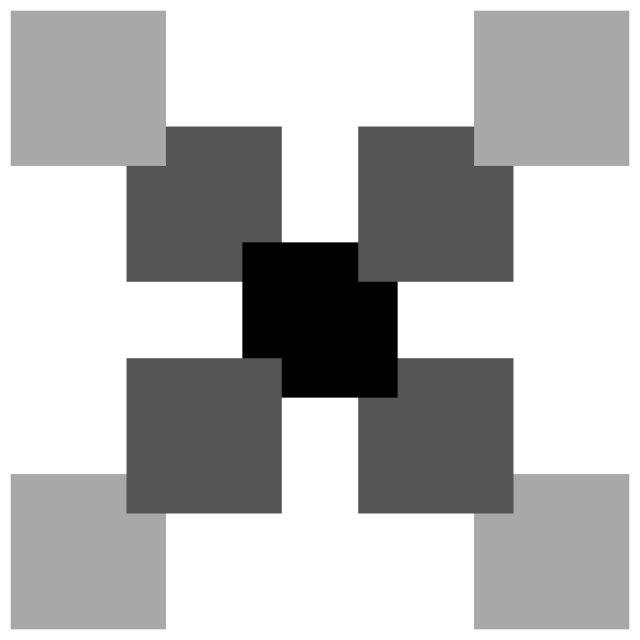L’ordine con cui appaiono le chiamate delle regole influenza l’ordine con cui le figure saranno renderizzate e quindi gli effetti di sovrapposizione

Il quadrato nero, disegnato per ultimo si trova al livello più alto
startshape LIVELLO
shape LIVELLO
{
SQUARE [ x -1.50 y -1.50 brightness 0.6 ]
SQUARE [ x -1.50 y +1.50 brightness 0.6 ]
SQUARE [ x +1.50 y -1.50 brightness 0.6 ]
SQUARE [ x +1.50 y +1.50 brightness 0.6 ]
SQUARE [ x -0.75 y -0.75 brightness 0.3 ]
SQUARE [ x -0.75 y +0.75 brightness 0.3 ]
SQUARE [ x +0.75 y -0.75 brightness 0.3 ]
SQUARE [ x +0.75 y +0.75 brightness 0.3 ]
SQUARE [ ]
}Se si vuole spostare indietro il quadrato nero bisogna spostare la chiamata corrispondente prima delle altre

startshape LIVELLO
shape LIVELLO
{
SQUARE [ ]
SQUARE [ x -1.50 y -1.50 brightness 0.6 ]
SQUARE [ x -1.50 y +1.50 brightness 0.6 ]
SQUARE [ x +1.50 y -1.50 brightness 0.6 ]
SQUARE [ x +1.50 y +1.50 brightness 0.6 ]
SQUARE [ x -0.75 y -0.75 brightness 0.3 ]
SQUARE [ x -0.75 y +0.75 brightness 0.3 ]
SQUARE [ x +0.75 y -0.75 brightness 0.3 ]
SQUARE [ x +0.75 y +0.75 brightness 0.3 ]
} Per ottenere un effetto qualsiasi con i livelli, senza dover ristrutturare il codice è possibile utilizzare il parametro z che specifica a quale livello sarà renderizzata una figura rispetto alle altre

Alcuni valori di z sono superflui, rispetto all’effetto voluto, ma sono stati specificati per completezza
startshape LIVELLO
shape LIVELLO
{
SQUARE [ z 0 ]
SQUARE [ x -0.75 y -0.75 z +1 brightness 0.3 ]
SQUARE [ x -0.75 y +0.75 z -1 brightness 0.3 ]
SQUARE [ x +0.75 y -0.75 z -1 brightness 0.3 ]
SQUARE [ x +0.75 y +0.75 z 0 brightness 0.3 ]
SQUARE [ x -1.50 y -1.50 z 0 brightness 0.6 ]
SQUARE [ x -1.50 y +1.50 z -1 brightness 0.6 ]
SQUARE [ x +1.50 y -1.50 z -2 brightness 0.6 ]
SQUARE [ x +1.50 y +1.50 z +2 brightness 0.6 ]
}